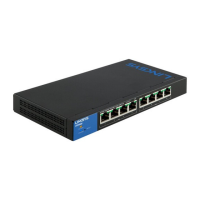94
Table of Contents
Linksys
Table of Contents
Linksys
• Weighted Round Robin (WRR)—In WRR mode, the number of packets
sent from the queue is proportional to the weight of the queue (the
higher the weight the more frames are sent). For example, if there are
a maximum of four queues possible and all four queues are WRR and
the default weights are used, queue 1 receives 1/15 of the bandwidth
(assuming all queues are saturated and there is congestion), queue 2
receives 2/15, queue 3 receives 4/15 and queue 4 receives 8 /15 of the
bandwidth. The type of WRR algorithm used in the device is not the
standard Deficit WRR (DWRR), but rather Shaped Deficit WRR (SDWRR).
The queuing modes can be selected in the Queue Scheduling page. When the
queuing mode is by strict priority, the priority sets the order in which queues
are serviced, starting with Queue 4 (the highest priority queue) and going to
the next lower queue when each queue is completed.
When the queuing mode is Weighted Round Robin, queues are serviced until
their quota has been used up and then another queue is serviced.
It is also possible to assign some of the lower queues to WRR, while keeping
some of the higher queues in strict priority. In this case, traffic for the strict
priority queues is always sent before traffic from the WRR queues. Only after
the strict priority queues have been emptied is traffic from the WRR queues
forwarded. (The relative portion from each WRR queue depends on its weight).
To select the priority method and enter WRR data.
STEP 1 Click Configuration > Quality of Service > Queue Scheduling.
STEP 2 Enter the parameters.
• Queue—Displays the queue number.
• Scheduling Method: Select one of the following options:
• Strict Priority—Traffic scheduling for the selected queue and all
higher queues is based strictly on the queue priority.
• WRR—Traffic scheduling for the selected queue is based on WRR. The
period time is divided between the WRR queues that are not empty,
meaning they have descriptors to egress. This happens only if strict
priority queues are empty.
• WRR Weight—If WRR is selected, enter the WRR weight assigned to
the queue.
• % of WRR Bandwidth—Displays the amount of bandwidth assigned
to the queue. These values represent the percent of the WRR weight.
STEP 3 Click Apply. The queues are configured, and the Running
Configuration file is updated.
CoS/802.1p to Queue
The CoS/802.1p to Queue page maps 802.1p priorities to egress queues. The
CoS/802.1p to Queue Table determines the egress queues of the incoming
packets based on the 802.1p priority in their VLAN Tags. For incoming
untagged packets, the 802.1p priority is the default CoS/802.1p priority
assigned to the ingress ports.
The following table describes the default mapping:
802.1p Values (0-7,
7 being the highest)
Queue (4 queues 1-4, 4
being the highest priority)
Notes
0 1 Background
1 1 Best Effort
2 2 Excellent Effort
3 3 Critical Application VoIP
phone SIP
4 3 Video
5 4 Voice Cisco IP phone
default
6 4 Interwork Control VoIP
phone RTP
7 4 Network Control
By changing the CoS/802.1p to Queue mapping (CoS/802.1p to Queue page),
the Queue schedule method (Queue Scheduling page) and bandwidth
allocation (Bandwidth page), it is possible to achieve the desired quality of
service in a network.
The CoS/802.1p to Queue mapping is applicable only if one of the
following exists:
• The device is in QoS Basic mode and CoS/802.1p trusted mode
Queue 1 has the lowest priority; queue 4 has the highest priority.
To map CoS /802.1p values to egress queues:
STEP 1 Click Configure> Quality of Service > CoS/802.1p to Queue.
STEP 2 Enter the parameters.

